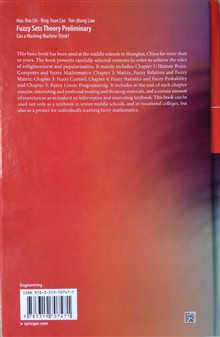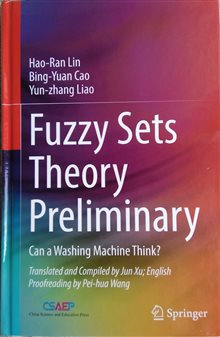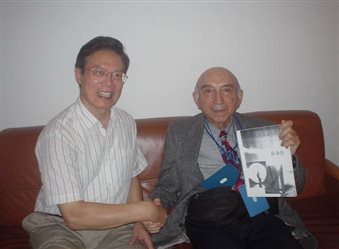



(广科新闻网讯)由我校外语外贸学院徐俊老师翻译的《模糊集合论初步》英文版已由世界著名出版社Springer和香港中华科教出版社联合出版发行,译著于2018年2月出版。该书中文版由我校财经学院院长曹炳元教授及外校的林浩然老师、廖运章教授编著,我校外语外贸学院徐俊老师编译,管理学院王佩华副教授校对,版权页上有我校英文名称。

springer是Springer-Verlag的简称,德国Springer-Verlag(斯普林格)出版社是世界上最大的科技出版社之一,它有着170多年发展历史,以出版学术性出版物而闻名于世,它也是最早将纸本期刊做成电子版发行的出版商。
翻译的过程也就是学习人工智能(Artificial Intelligence)的过程。要让机器人拥有“智慧”,需要依靠模糊数学的算法来实现。依靠模糊集合来实现模糊控制,可以优化计算机的运算过程,使机器人反应更快、更有“智能”。

(图为:模糊数学创始人、美国加州大学L.A.Zadeh教授与林浩然老师)
著名控制论专家、美国加州大学教授扎德(L.A.Zadeh)于1965年首先提出模糊集(Fuzzy sets)的概念,奠定了模糊性理论的基础。这一理论由于在处理复杂系统特别是有人干预的系统方面具有简捷而有力的优势,迅速受到广泛重视。几十年来,在权威不间断的质疑声中,这个领域从理论到应用,从软技术到硬技术都取得了丰硕的成果。此书的目录如下:
Fuzzy Sets Theory Preliminary
0 Introduction . . . . . . . . . . . . . . . . . . . . . . . . . . . . . . xix
0.1 Defects in Sets . . . . . . . . . . . . . . . . . . . . . . . . . . .xix
0.2 Sets Expanded to Fuzzy Sets . . . . . . . . . . . . . . . . . . . . . . . .xix
0.3 Enhancing Intelligence by Mathematics Development . . . . . . . .xx
0.4 Artificial Intelligence . . . . . . . . . . . . . . . . . . . . . . . . . . .xx
0.5 Can a Machine Think? . . . . . . . . . . . . . . . . . . . . . . . . . . . . .xxi
0.6 Can a Washing Machine Think? . . . . . . . . . . . . . . . . . . . . . . .xxii
0.7 Artificial Intelligence Development Prospects . . . . . . . . . . .xxii
0.8 Can Computer Intelligence Exceed Human Brain? . . . . . . . . . . .xxiii
1 Human Brain, Computer and Fuzzy Mathematics . . . . . . . . . . . . 1
1.1 Fuzzy Mathematics . . . . . . . . . . . . . . . . . . . . . . . . . . . .1
1.1.1 Old or Not Old . . . . . . . . . . . . . . . . . . . . . . . . . . . . .1
1.1.2 How Many Grains is in a Pile of Sand? . . . . . . . . . . . . 1
1.1.3 Fuzziness is Everywhere, Visible at Any Time . . . . . . . . 2
1.2 Birth of Fuzzy Mathematics . . . . . . . . . . . . . . . . . . . . .2
1.2.1 Mathematics Started from “Fuzzy” . . . . . . . . . . . . . . . 3
1.2.2 Economic Development and Mathematics Development . . . . . . 3
1.2.3 Traditional Mathematics Cannot Solve Fuzzy
Phenomena . . . . . . . . . . . . . . . . . . . . . . . . . . . . . . 3
1.2.3.1 Bald Paradox . . . . . . . . . . . . . . . . . . . . . . . . 3
1.2.4 Computer Limitation . . . . . . . . . . . . . . . . . . . . . . 4
1.2.4.1 Early Computer is Not as Smart as a Baby;
Robot Turnkeys . . . . . . . . . . . . . . . . . . . . . . . . . 4
1.2.5 Structure and Thinking of Human Brain . . . . . . . . . . . . 5
1.2.5.1 Human Brain; Nerve Cells . . . . . . . . . . . . . . . . . 5
1.2.5.2 Synapses—Powerful “Circuit” Switches . . . . . . . . . . 6
1.2.6 Birth of Fuzzy Mathematics . . . . . . . . . . . . . . . . . . . . 10
1.2.6.1 How to Teach a Computer to Recognize
Handwriting: a and d—Found by Prof. Zadeh . . . 10
1.3 Sets . . . . . . . . . . . . . . . . . . . . . . . . . . . . . . . . 11
1.3.1 Concept and Characteristics . . . . . . . . . . . . . . . . . 11
1.3.2 Representation of Sets . . . . . . . . . . . . . . . . . . . . 11
1.4 Fuzzy Sets . . . . . . . . . . . . . . . . . . . . . . . . . . . . . 12
1.4.1 Concepts . . . . . . . . . . . . . . . . . . . . . . . . . . . . 12
1.4.1.1 Visual Images of Sets and Fuzzy Sets . . . . . . . . . 12
1.4.1.2 Searching with Keywords is Fuzzy
Technology . . . . . . . . . . . . . . . . . . . . . . . . . . . 14
1.4.2 Membership Function and Membership Degree . . . . . . . . . 14
1.4.2.1 Sets—Characteristic Function; Fuzzy
Sets—Membership Function . . . . . . . . . . . . . . . . 14
1.4.3 Representation of Fuzzy Sets . . . . . . . . . . . . . . . . . 15
1.4.4 Determination of Membership Functions . . . . . . . . . . . . 19
1.4.4.1 Fuzzy Statistics . . . . . . . . . . . . . . . . . . . . 19
1.4.5 Operations of Fuzzy Sets . . . . . . . . . . . . . . . . . . . 24
1.4.6 Fuzzy Operators . . . . . . . . . . . . . . . . . . . . . . . . 31
1.4.7 Cut Sets . . . . . . . . . . . . . . . . . . . . . . . . . . . . 34
Summary . . . . . . . . . . . . . . . . . . . . . . . . . . . . . . . . 38
2 Matrix, Fuzzy Relation and Fuzzy Matrix . . . . . . . . . . . . . 41
2.1 Introduction . . . . . . . . . . . . . . . . . . . . . . . . . . . 41
2.1.1 Matrix Represents a Form; Matrix Describes
a Network . . . . . . . . . . . . . . . . . . . . . . . . . . . 41
2.1.2 Matrix Describes a Relation . . . . . . . . . . . . . . . . 42
2.2 The Concept of a Matrix . . . . . . . . . . . . . . . . . . . . . 43
2.3 Matrix’s Addition, Subtraction and Multiplication . . . . . . 44
2.3.1 Matrix’s Addition and Subtraction . . . . . . . . . . . . . 45
2.3.2 Multiplication of a Number and a Matrix . . . . . . . . . . 46
2.3.3 Multiplication of Matrices . . . . . . . . . . . . . . . . . 47
2.4 Relation . . . . . . . . . . . . . . . . . . . . . . . . . . . . . 52
2.4.1 The Concept of Relation . . . . . . . . . . . . . . . . . . 52
2.4.2 Relation Representation . . . . . . . . . . . . . . . . . . 53
2.5 Fuzzy Relation and Fuzzy Matrix . . . . . . . . . . . . . . . . . 54
2.6 Operations of Fuzzy Relation . . . . . . . . . . . . . . . . . . 57
2.7 Synthesis of Fuzzy Relation . . . . . . . . . . . . . . . . . . . 59
2.7.1 Origin of Synthesis . . . . . . . . . . . . . . . . . . . . 59
2.7.2 Definition and Operations of Synthesis . . . . . . . . . . 60
Summary . . . . . . . . . . . . . . . . . . . . . . . . . . . . . . . . 71
3 Fuzzy Control . . . . . . . . . . . . . . . . . . . . . . . . . . . . . . 73
3.1 Fuzzy Control Full-Automatic Washing Machine . . . . . . . . . 73
3.1.1 Laundry Conditions . . . . . . . . . . . . . . . . . . . . . 74
3.1.2 Structure and Sensors of Fuzzy Control Full-Automatic
Washing Machine . . . . . . . . . . . . . . . . . . . . . . . 75
3.2 A Brief Introduction to Fuzzy Control Theory . . . . . . . . . 80
3.3 Fuzzification of Precise Amount . . . . . . . . . . . . . . . . . 84
3.4 Fuzzy Inferences . . . . . . . . . . . . . . . . . . . . . . . . . . . . . . .86
3.5 Defuzzification of Fuzzy Amount . . . . . . . . . . . . . . . . . 95
Summary . . . . . . . . . . . . . . . . . . . . . . . . . . . . . . . . 108
4 Fuzzy Statistics and Fuzzy Probability . . . . . . . . . . . . . . . . 109
4.1 Random Phenomena and Fuzzy Phenomena . . . . . . . . . . . . . . 109
4.2 Fuzzy Statistics . . . . . . . . . . . . . . . . . . . . . . . . . 111
4.2.1 Test Methods to Fuzzy Statistics . . . . . . . . . . . . . 112
4.2.2 Fuzzy Data and Operations . . . . . . . . . . . . . . . . . 114
4.2.3 Descriptive Statistics of Fuzzy Data . . . . . . . . . . . 116
4.3 Fuzzy Probability . . . . . . . . . . . . . . . . . . . . . . . . 121
4.3.1 Fuzzy Probability Theory . . . . . . . . . . . . . . . . . . 121
4.3.2 Probability of Fuzzy Events . . . . . . . . . . . . . . . . 122
Summary . . . . . . . . . . . . . . . . . . . . . . . . . . . . . . . . 134
5 Fuzzy Linear Programming . . . . . . . . . . . . . . . . . . . . . . . 135
5.1 Ordinary Linear Programming and Fuzzy Linear Programming . . . 135
5.2 Binary FLP and Graphics . . . . . . . . . . . . . . . . . . . . . 136
5.3 Application and Excel Solutions to Binary FLP . . . . . . . . . 140
Summary . . . . . . . . . . . . . . . . . . . . . . . . . . . . . . . . 148
References . . . . . . . . . . . . . . . . . . . . . . . . . . . . . . . . 149

